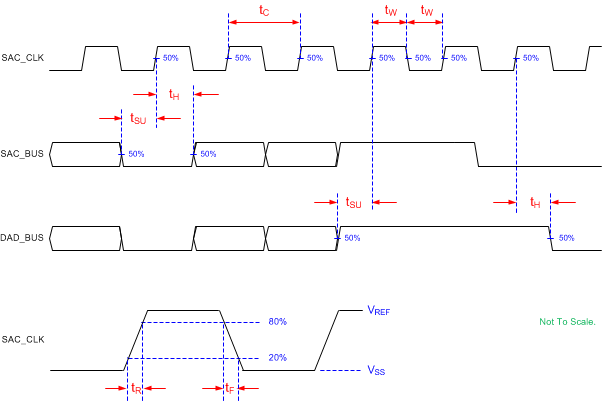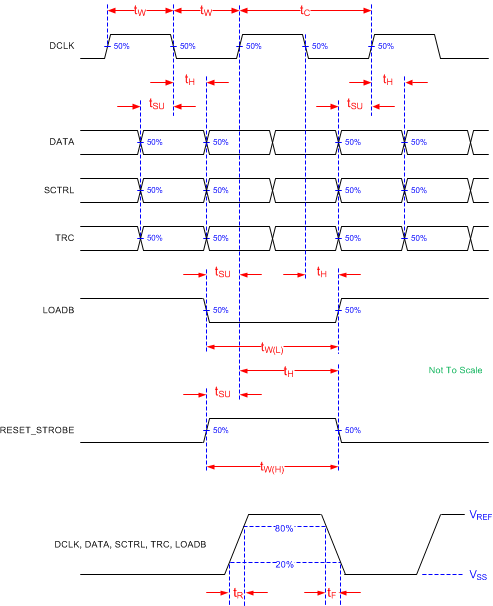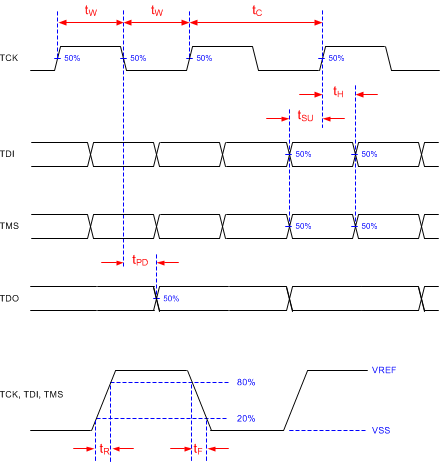DLPS076B November 2017 – June 2019 DLP3030-Q1
PRODUCTION DATA.
- 1 Features
- 2 Applications
- 3 Description
- 4 Revision History
- 5 Pin Configuration and Functions
-
6 Specifications
- 6.1 Absolute Maximum Ratings
- 6.2 Storage Conditions
- 6.3 ESD Ratings
- 6.4 Recommended Operating Conditions
- 6.5 Thermal Information
- 6.6 Electrical Characteristics
- 6.7 Timing Requirements
- 6.8 Switching Characteristics
- 6.9 System Mounting Interface Loads
- 6.10 Physical Characteristics of the Micromirror Array
- 6.11 Optical Characteristics of the Micromirror Array
- 6.12 Window Characteristics
- 6.13 Chipset Component Usage Specification
- 7 Detailed Description
- 8 Application and Implementation
- 9 Power Supply Recommendations
- 10Layout
- 11Device and Documentation Support
- 12Mechanical, Packaging, and Orderable Information
Package Options
Mechanical Data (Package|Pins)
- FYJ|149
Thermal pad, mechanical data (Package|Pins)
Orderable Information
6.7 Timing Requirements
Over Recommended Operating Conditions unless otherwise noted.| MIN | NOM | MAX | UNIT | ||
|---|---|---|---|---|---|
| DMD MIRROR AND SRAM CONTROL LOGIC SIGNALS | |||||
| tSU | Setup time SAC_BUS low before SAC_CLK↑ | 1.0 | ns | ||
| tH | Hold time SAC_BUS low after SAC_CLK↑ | 1.0 | ns | ||
| tSU | Setup time DAD_BUS high before SAC_CLK↑ | 1.0 | ns | ||
| tH | Hold time DAD_BUS after SAC_CLK↑ | 1.0 | ns | ||
| tC | Cycle time SAC_CLK | 12.5 | 16.67 | ns | |
| tW | Pulse width 50% to 50% reference points: SAC_CLK high or low | 5.0 | ns | ||
| tR | Rise time 20% to 80% reference points: SAC_CLK | 2.5 | ns | ||
| tF | Fall time 80% to 20% reference points: SAC_CLK | 2.5 | ns | ||
| DMD DATA PATH AND LOGIC CONTROL SIGNALS | |||||
| tSU | Setup time DATA(14:0) before DCLK↑ or DCLK↓ | 1.0 | ns | ||
| tH | Hold time DATA(14:0) after DCLK↑ or DCLK↓ | 1.0 | ns | ||
| tSU | Setup time SCTRL before DCLK↑ or DCLK↓ | 1.0 | ns | ||
| tH | Hold time SCTRL after DCLK↑ or DCLK↓ | 1.0 | ns | ||
| tSU | Setup time TRC before DCLK↑ or DCLK↓ | 1.0 | ns | ||
| tH | Hold time TRC after DCLK↑ or DCLK↓ | 1.0 | ns | ||
| tSU | Setup time LOADB low before DCLK↑ | 1.0 | ns | ||
| tH | Hold time LOADB low after DCLK↓ | 1.0 | ns | ||
| tSU | Setup time RESET_STROBE high before DCLK↑ | 1.0 | ns | ||
| tH | Hold time RESET_STROBE after DCLK↑ | 3.5 | ns | ||
| tC | Cycle time DCLK | 12.5 | 16.67 | ns | |
| tW | Pulse width 50% to 50% reference points: DCLK high or low | 5.0 | ns | ||
| tW(L) | Pulse width 50% to 50% reference points: LOADB low | 7.0 | ns | ||
| tW(H) | Pulse width 50% to 50% reference points: RESET_STROBE high | 7.0 | ns | ||
| tR | Rise time 20% to 80% reference points: DCLK, DATA, SCTRL, TRC, LOADB | 2.5 | ns | ||
| tF | Fall time 80% to 20% reference points: DCLK, DATA, SCTRL, TRC, LOADB | 2.5 | ns | ||
| JTAG BOUNDARY SCAN CONTROL LOGIC SIGNALS | |||||
| fTCK | Clock frequency TCK | 10 | MHz | ||
| tC | Cycle time TCK | 100 | ns | ||
| tW | Pulse width 50% to 50% reference points: TCK high or low | 10 | ns | ||
| tSU | Setup time TDI valid before TCK↑ | 5 | ns | ||
| tH | Hold time TDI valid after TCK↑ | 25 | ns | ||
| tSU | Setup time TMS valid before TCK↑ | 5 | ns | ||
| tH | Hold time TMS valid after TCK↑ | 25 | ns | ||
| tR | Rise time 20% to 80% reference points: TCK, TDI, TMS | 2.5 | ns | ||
| tR | Fall time 80% to 20% reference points: TCK, TDI, TMS | 2.5 | ns | ||
 Figure 1. DMD Mirror and SRAM Control Logic Timing Requirements
Figure 1. DMD Mirror and SRAM Control Logic Timing Requirements  Figure 2. DMD Data Path and Control Logic Timing Requirements
Figure 2. DMD Data Path and Control Logic Timing Requirements  Figure 3. JTAG Boundary Scan Control Logic Timing Requirements
Figure 3. JTAG Boundary Scan Control Logic Timing Requirements